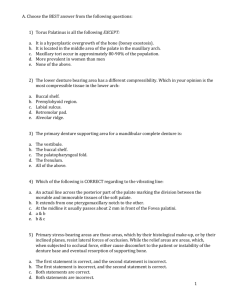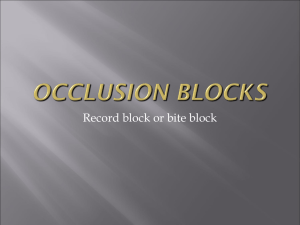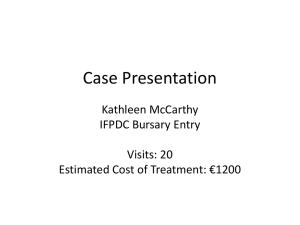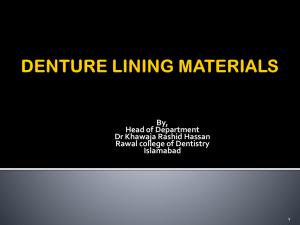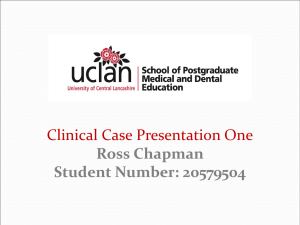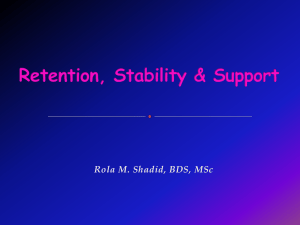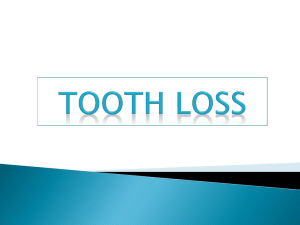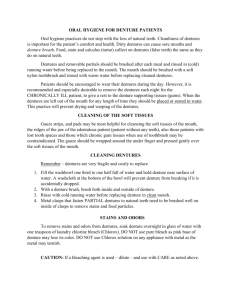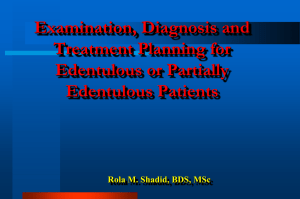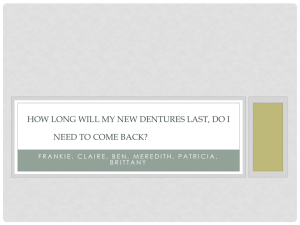21. Immediate Denture - Removable Prosthodontics
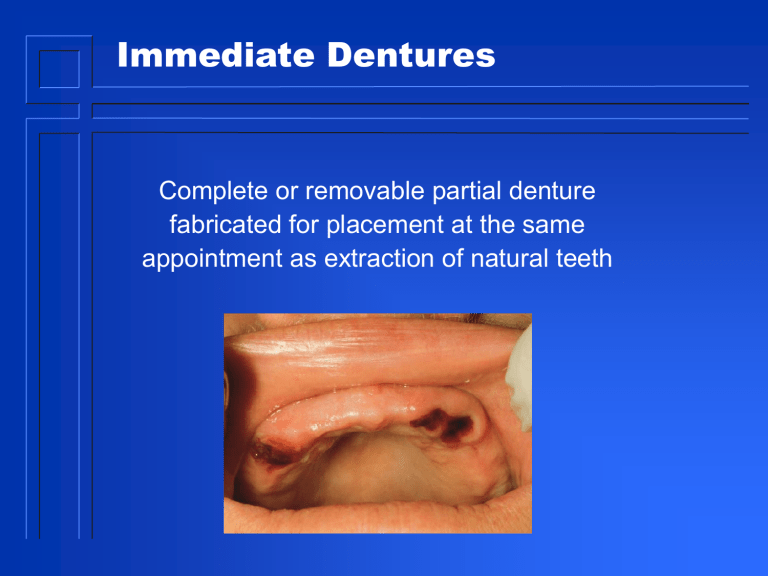
Immediate Dentures
Complete or removable partial denture fabricated for placement at the same appointment as extraction of natural teeth
Occlusion May be Mutilated
Makes Jaw Relations Difficult
OVD, Midline & Incisal Edges May Require Change
After Extractions, Prior to Placement
Final Result
Immediate Complete Denture
• Conventional immediate denture
• intended to be relined to serve long-term
• Interim immediate denture (IID) (transitional):
• after healing a second new complete denture is fabricated as a long-term prosthesis
(Zarb, G. Prosthodontic Treatment for Edentulous Patients, 12th Edition . Elsevier, 2003. 9.1)
Advantages
• Maintenance of
• Appearance
• Circumoral support
• Muscle tone
• Occlusal vertical dimension
• Jaw relationships
• Facial height
• Tongue will not spread out as result of tooth loss
Zarb, G. Prosthodontic Treatment for Edentulous Patients, 12th Edition . Elsevier, 2003. 9.2.1
Advantages
• Less postoperative pain & bleeding
• extraction sites protected
• Pressure from denture base
• Easier to duplicate natural tooth shape & position (if desired)
• Easier Adaptation
• Speech, mastication rarely compromised
• Nutrition can be maintained
Zarb, G. Prosthodontic Treatment for Edentulous Patients, 12th Edition . Elsevier, 2003. 9.2.1
Disadvantages
• More challenging to set teeth
– Less space for teeth as ridge resorption hasn’t occurred
• Alveolar ridge undercuts around remaining teeth may make impressions more difficult
• Unstable or inadequate occlusion can make recording centric position difficult
Unstable Occlusion
Explanation to Patients
• Fit is usually not as good as traditional dentures (estimate ridge form)
• Extractions and sore spots from immediate denture can result in more discomfort after initial insertion
Zarb, G. Prosthodontic Treatment for Edentulous Patients, 12th Edition . Elsevier, 2013. 9.4.3.1
Explanation to Patients
• Takes time to adapt to chewing and speaking
• Appearance may be unpredictable if anterior try-in not possible
(Zarb, G. Prosthodontic Treatment for Edentulous Patients, 12th Edition . Elsevier, 2013. 9.4.3.1)
No Anterior Try-in
Explanation to Patients
• Should be worn for first 24 hours without removal
• If removed, reinsertion can be difficult if significant swelling occurs
• Patient should return to dental office for initial removal at 24-hours
Explanation to Patients
• Immediate dentures will normally “ loosen ” during healing due to ridge resorption & soft tissue remodeling
• Relines/tissue conditioners will be required to improve the retention
• Normally a permanent reline will be required 4-6 months after insertion
Explanation to Patients
• In some cases a remake may be required
• Significant change in jaw position
• Significant esthetic problem
• May be cheaper/better to remake
• In practice, the patient is normally responsible for fees for relines
• Explain prior to beginning
Dalhousie Faculty of Dentistry Policy
• Immediate denture fee at Dalhousie includes
• tissue conditioners
• one permanent reline within first year of receiving immediate denture(s)
• No additional fees for relines
Dalhousie Protocols
• Online on Removable Prosthodontics Website
• http://removpros.dentistry.dal.ca/RemovSite/Imm ed_Dentures.html
Too Difficult
• No opposing occlusal contacts
• Severely collapsed occlusal vertical dimension
• Can’t register a repeatable jaw relationship
(check at treatment planning appointment)
• Vestibule too short - vestibuloplasty would be required
• Refer
Dalhousie Protocols
• Sugery & Insertions Thursday afternoons only
• Book at least 2 weeks prior to surgery
• Book with Patient Services Staff
• Identify as a Immediate Dent at time of booking
• Only 2 immediate denture bookings per day
• Email Dr. Knechtel to advise him of booking
• date of booking
• # of teeth to be extracted
• CD (single or set)
• RPD
Dalhousie Protocols
• At least one week prior, students must review medical history & clinical surgical details with supervising surgeon
• At beginning of clinic inform both attending
Surgeon and Dr. Knechtel that your patient has an immediate denture
• This ensures the patient moves to top of rotation, so that insertion is as early in clinic as possible
Dalhousie Protocols
• Students must see patient the day after delivery ,
Friday morning to ensure patient comfortable
• All immediate dentures insertions supervised by
Dr. Knechtel.
Technique
• Examination/Diagnosis/Treatment Plan
• Informed consent
• Alternatives
• Pros/cons
• Prognosis
• Timing
• Costs
Examination/Diagnosis/Treatment Plan
• Beware of tissue undercuts
• Especially anterior maxilla & tuberosities
• Make notes to reduce at time of extractions
• Compress socket
• Bony reduction if necessary
• If not reduced, denture may not seat
• 2 piece tray for impression
Examination/Diagnosis/Treatment Plan
• Determine if OVD requires change at diagnosis appointment
• Use physiologic rest, interocclusal space measurements
Examination/Diagnosis/Treatment Plan
• To improve esthetics & ensure adequate stability:
• Decide whether you will need to imitate or change tooth arrangement prior to beginning
• Helps avoid unexpected surprises
Technique
• Oral hygiene procedures
• Reduce inflammation to speed healing
• Reduced discomfort after extractions
• Less soft tissue changes – better fit
Technique
• Preliminary extractions - posterior teeth
• Keep one set of opposing teeth on each side of arch if
OVD and centric are to be preserved
• Wait 4 weeks for healing
• If very few teeth remain
• Consider extracting all at once
• Skip preliminary extraction step
• Less morbidity
Extract All Teeth Single Appointment
Technique After Preliminary Extractions
• Preliminary impressions - alginate
• Final impressions – 1 or 2 step
• Jaw relation records
• Tooth set-up and try-in
• Final extractions and insertion
• Post insertion care
Examination/Diagnosis/Treatment Plan
• Reconfirm decision to imitate or change tooth arrangement
• Determine midlines, occlusal plane, vertical overlap, length of maxillary incisors
• Mark on cast for laboratory to use for setup
Preliminary impressions
• Stock trays
• Dentate or partially-edentulous
• Irreversible Hydrocolloid
• Mark vibrating line & hamular notches prior to impression
• Can’t reseat intraorally
Final Impressions
• Use 2 piece custom tray if significant undercuts
• If no large tissue undercuts use one piece custom tray
Mark Posterior Border Prior to Impression
• Vibrating line & hamular notches
• Not able to reseat intraorally
• tooth & tissue undercuts, embrasures
• If don ’t have correct posterior border, denture will not be retentive
2 Piece Impression
Custom Tray – Ensure
Alginate Not Too Thin
Stock Tray
1 Piece Impression
• Block out minor undercuts
• Ensure tray flange not too far from vestibule
• After border molding, should not lock into place
Jaw relation records
• Record base & occlusion rim used if unstable cast/contacts
(wobbles, rocks)
• Make facebow record with dentate bitefork
• Use for centric & protrusion
• If stable contacts, record base not needed
Jaw Relation Records
• Determine OVD
• Use physiologic rest, interocclusal space measurements
• Do NOT incorporate an overbite in occlusion rims
• if anterior teeth are missing, use rims only to determine OVD, not incisal display
• Once mounted, determine overbite, incisal display required
Use occlusion rims for OVD, Jaw Relations Records
Dentate Bitefork wth Wax/PVS
Centric Record
Use PVS Bite Registration Material, NOT Wax
Tooth Set-up and Try-in
Anterior Try-in Only Possible if Anterior Teeth Missing
Extraction and Insertion
• Have lab complete set up & modify cast as directed
• use probing depths & radiographs to guide cast modification
Do not create large socket convexities – grind teeth
Final Setup Usually will not allow for Full Wax Try-in
Extraction and Insertion
• Always request a surgical stent (guide)
• Prescribe fabrication of stent when sent for processing
• Allows for identifying areas of impingement (blanching)
Extraction and Insertion
• Extract teeth
• Prior to insertion, use surgical guide to assess ridge
• Place pressure but DONOT Flex during insertion
• check for over extensions, pressure (blanching)
• Seat the denture
• After stent show full seating, no blanching
Extraction and Insertion
THE DENTURE MUST BE FULLY SEATED
• Otherwise occlusion will be unacceptable
• Once fully seated, adjust occlusion as needed
• Provide post insertion instructions
• Verbal
• Written – patient brochure
Dalhousie Timeline for Insertion
0 -15 min
- Inform surgeon & Dr. Knechtel patient is receiving an immediate denture
- review med history
- provide local anaesthesia
15 - 60 min
- extractions
1 - 2 hour
- insert and adjust
- instructions
Instructions to Patient
• Do not remove until 24 hour appointment
• If it comes loose/out replace immediately
• Soft/liquid diet for 24 hours
• Avoid vigorous rinsing
• Take analgesic as prescribed
• Expect red saliva
24 Hour Appointment
• Remove and clean denture
• Relieve sore spots
• Do not use PIP – use indelible stick
• Gross occlusal adjustment
1 Week Recall Appointment
• Relieve sore spots
• Use PIP
• Refine occlusion – possible remount
Continuing Care
• Tissue conditioner to improve retention as needed
• Remove any socket convexities to avoid healing defects
• Reline or remake in 4 to 6 months
• Postpone as long as patient can tolerate to ensure most of initial resorption complete
X
X
Remove denture base convexities to avoid healing defects
X
